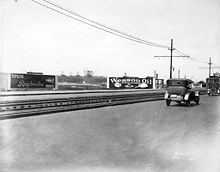Route selection and dedication
September 1920 photo near the intersection of Broad Street and Northeast Boulevard in Philadelphia
Essex and Hudson Lincoln Highway in Jersey City, New Jersey
The Trail-Blazers returned to Indianapolis by train, and a few weeks later on September 14, 1913, the route was announced. LHA leaders, particularly Packard president Henry Joy, wanted as straight a route as possible and the 3,389-mile (5,454 km) route announced did not necessarily follow the course of the Trail-Blazers. There were many disappointed town officials, particularly in Colorado and Kansas, who had greeted the Trail-Blazers and thought the tour's passage had meant their towns would be on the Highway.
Less than half the selected route was improved roadway. As segments were improved over time, the route length was reduced by about 250 miles (400 km). Several segments of the Lincoln Highway route followed historic roads:
- a road laid out by Dutch colonists of New Jersey before 1675
- the 1796 Lancaster Turnpike in Pennsylvania
- the Chambersburg Turnpike, over which much of the Army of Northern Virginia marched to reach the Gettysburg Battlefield, a part of which is traversed by the Lincoln Highway.
- a British military trail built in 1758 by General John Forbes of England from Chambersburg to Pittsburgh during the French and Indian War, later known as the Pittsburgh Road and the Conestoga Road
- a section in Ohio followed an ancient Indian trail known as the Ridge Road
- sections of the Mormon Trail
- the Great Sauk Trail, an Indian trail through northwest Indiana
- portions of the routes of the Cherokee Trail, Overland Trail and the Pony Express
- the Donner Pass crossing of the Sierra Nevada, named after the unfortunate Donner Party of 1846
- an alternate Sierra Nevada crossing at Echo Summit following a pioneer stagecoach route


No comments:
Post a Comment